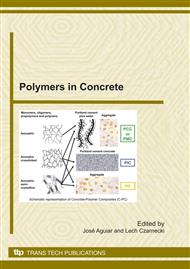p.1
p.15
p.21
p.29
p.37
p.47
p.57
p.65
p.73
The Effect of Latex and Chitosan Biopolymer on Concrete Properties and Performance
Abstract:
this paper presents the results of a study in which the combination of two polymeric additives in concrete with the intention of improving its mechanical and durability performance is analysed. The additives are a synthetic latex and a biopolymer – chitosan. An evaluation of the mechanical properties as well as the phases formed based on scanning electron microscopy (SEM) and X-ray diffraction (XRD) was performed. The concretes were prepared with each of the polymers separately, and the results were ordinary. However, when combined, the results show an interesting interaction improving the mechanical strengths of the concrete. Several concrete samples were prepared with 0 – 4 % of each polymer with 1 % increments. The mechanical properties were shown to be sensitive to the incorporation of polymers. The desired effect of the interaction between the biopolymer and the latex was observed, because the strengths increased when both additives were present, namely for the combination of 2 % of each polymer. SEM images revealed a heterogeneous distribution in the polymer cementitious matrix, mainly with regards to latex. The presence of well defined polymer fibers on a fracture surface of composites prepared with biopolymer (4 %) was observed, indicating that the fibre pullout and not fracture was the cause of failure, resulting from the poor adherence of the fibers in matrix. Composites prepared with both polymers revealed abundant formation of C-S-H and the absence of ettringite, explaining the improvement of mechanical properties. The presence of reticulated structures of C-S-H dispersed in the microstructure and involving the calcium hydroxide corroborates the results of mechanical properties, mainly for the percentages of 3 % of biopolymer and 1 % of latex.
Info:
Periodical:
Pages:
37-46
Citation:
Online since:
January 2011
Price:
Сopyright:
© 2011 Trans Tech Publications Ltd. All Rights Reserved
Share:
Citation:


